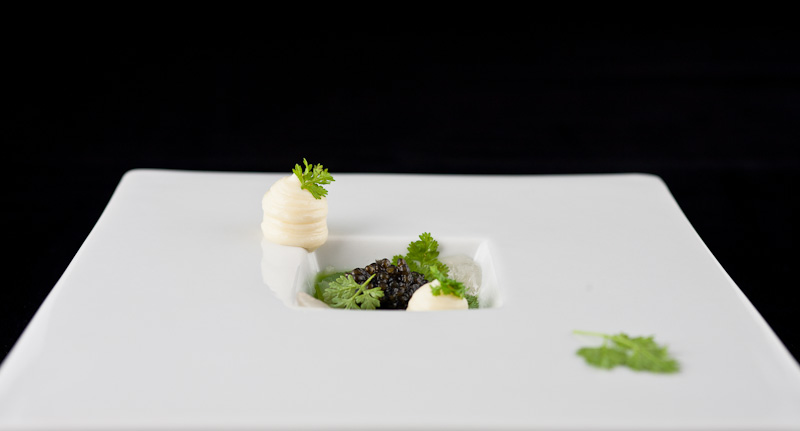
Back at the beginning of the year, Sarah and I took a weekend trip up north of the city to Tomales Bay. Squirreled away in the fog and foothills along the bay is a small oyster farm called the Tomales Bay Oyster Co. This place is a magical place where you can roll up with a picnic cooler filled with Bud Light Lime, some gloves and a shucking knife, and can buy a bag of live oysters that a cute blonde Australian gal hauls straight out of the water for you. The seawater splashes off the bag and the girl eyes you and asks “you know what to do with these?” before pointing you towards one of several dozen weathered picnic tables. This isn’t a restaurant and it’s not really a park; it’s just a beautiful area where you can shuck and devour as many oysters as you could ever possibly want. Nearby, families are grilling on the worn camping grills posted next to each table, or perhaps blaring mariachi music and lazily poking at some empty shells. It is so completely awesome that, in an email months ago to Chef Achatz when I found out he and Nick would be out here promoting their book, I mentioned that even if I didn’t get a chance to meet him while he was here, if he had a half-day to spare he should definitely check this place out. He responded with “Oh yeah, I’ve been to that place once. It’s awesome.”





In the months since, we’ve had several visitors. With almost every one, we offer to take them to this place to spend an afternoon basking in the sun and eating raw oysters. When my family came about a month ago, 6 of us managed to down 100 oysters, several Coors Lights, a bottle of Crystal, and another bottle of homemade cocktail sauce all in about 45 minutes.



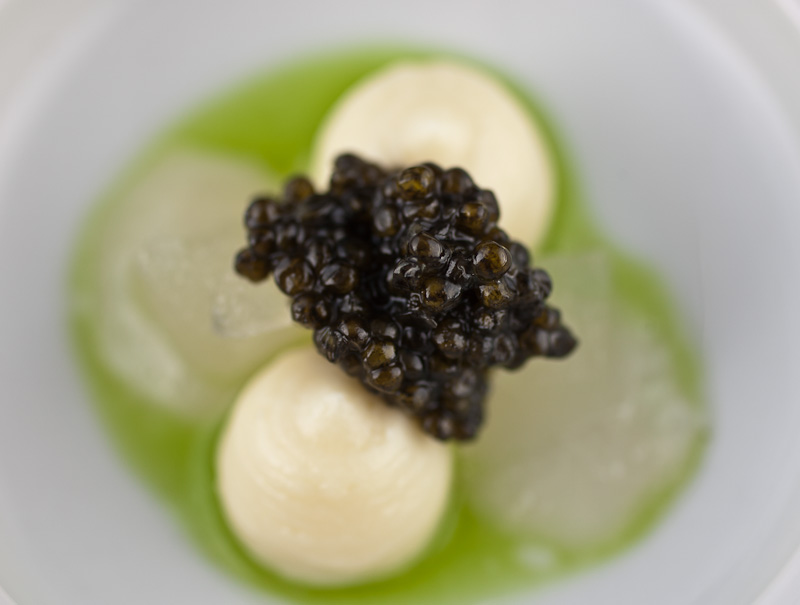
It probably goes without saying, then, that when I flipped across this recipe in trying to choose some summer recipes to try, the idea of playing with oysters was greatly appealing. This dish is a bit hilarious in the juxtapositions of texture and flavor it uses. The main component is “Oyster Cream”, which is just…cream cooked with oysters in it. Huh! After letting some oysters steep in a pot of boiled cream for a half-hour or so, the cream takes on the flavor of the oysters and some earthy notes that make the whole thing more than the sum of its parts. Sarah thought I’d used mushrooms in there somewhere, but nope, it’s just oysters. From the cream, we combine with some Agar, egg yolk, and cornstarch, to make a sort of pudding with some elasticity and firmness. This pudding, once set, is sheared in a blender to give a nice smooth puree.
Or, at least, that’s what it’s supposed to do. The first time through, my pudding was set extremely firmly, and blending it took a lot of cajoling. Just beyond the point that it started to smooth out, this happened:
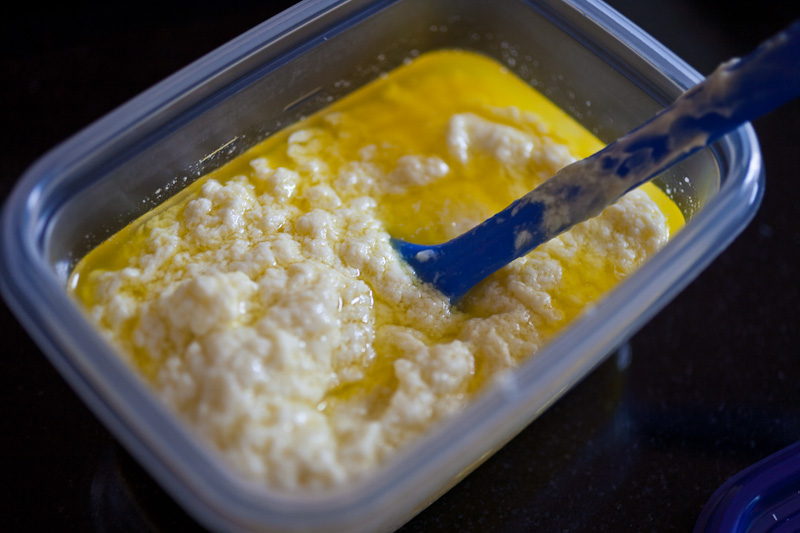
Honestly I have no idea what’s actually happening here. There’s no oil or butter added to this mixture, so I’m not sure what’s going on that would cause separation like this. I DO know that a scant second too long in the blender, and my nice puree goes all curdled and grody like this. Well, not GRODY…it still tastes great, but no one would want to eat something that looks like that. So, I remade the whole thing (grand total of oysters shucked: 24), this time being very, very careful with the blender and stopping periodically to re-chill the mixture when it started to warm up in the blender pot. This worked much better, but I was struck at how incredibly delicate and finicky this stuff is. It tastes pretty commonplace though; sweet and salty and oystery and luxurious.
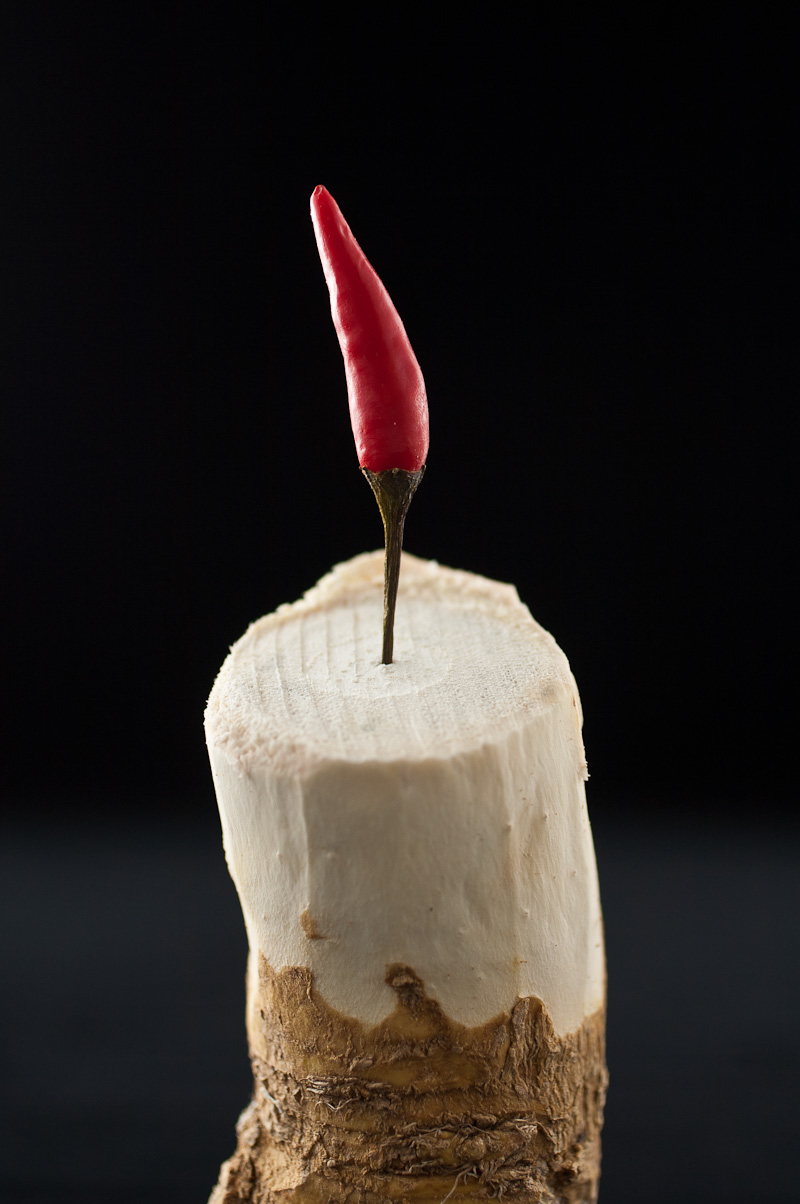
The oyster cream is paired with a gelee of horseradish and thai pepper. This stuff is so totally amazingly BAD ASS. I basically make yet another ‘tea’ of freshly-grated horseradish, chili, and vinegar, then let it steep for a half hour or so. After this time, I took the lid off and inhaled deeply, imagining I’d get a nice subtle scent of horseradish.
Instead, I felt like I’d gotten maced in the face.
Seriously, this stuff is SO STRONG. My eyeballs went numb, my nose was so confused that a sneeze turned into tears, and my face felt sunburned. It was awesome. The mixture is strained and mixed with some gelatin to set, then broken into little chunks. The chunks, thankfully, are much more delicate and manageable, sweet and with that wasabi-like front-end heat that’s there and gone.
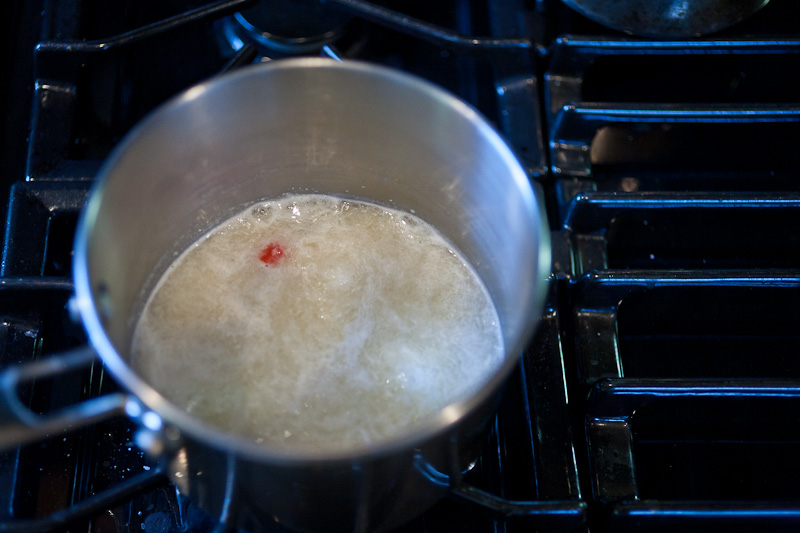
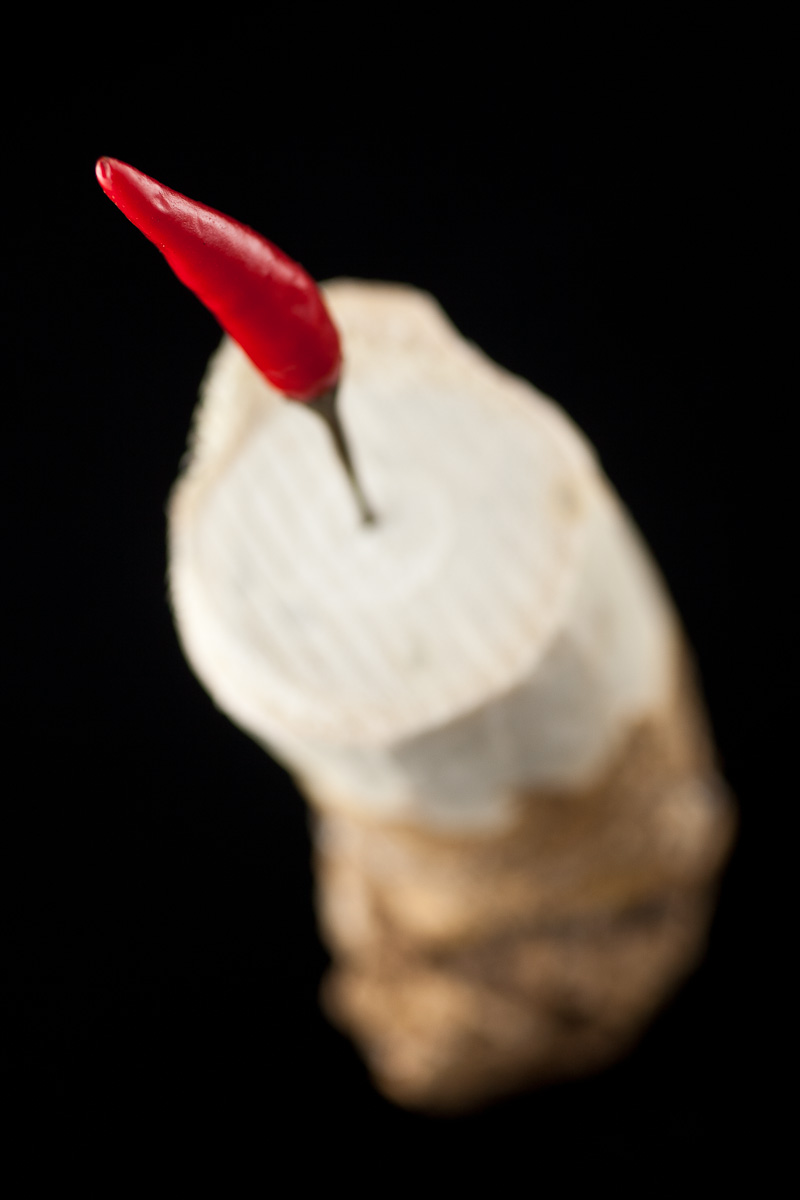
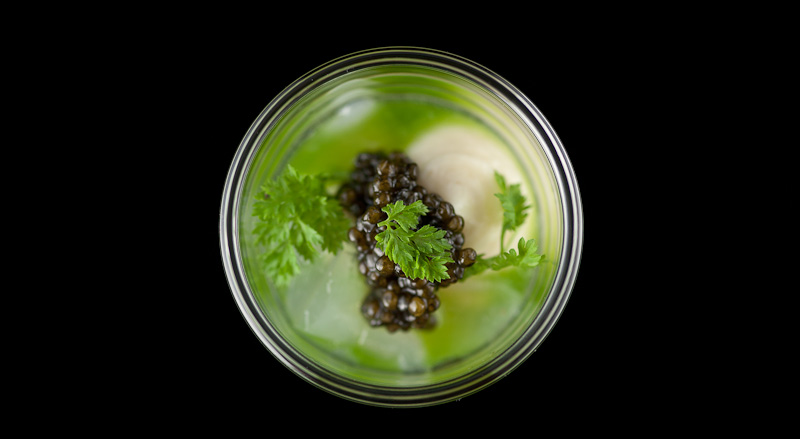
Also accenting the horseradish and oyster cream are small quarter-sized discs of Lychee. I’d never had lychee before! I knew what they were, but in jars they always looked gross to me. Berkeley Bowl sells them fresh, so I was excited to have a reason to try buying them. Lychees are pretty wild; they have a knurled, spiky exterior shell that can be peeled away easily. Inside is a gelatinous fruit with a pit. When I tasted it for the first time, the flavor reminded me immediately of rose water. So cool! The fruit is sliced into small discs that have the texture and look of something oyster-like. This is hilarious to me; when assembled, the horseradish and lychee look like oyster bits, while it’s the cream that carries the oyster flavor.
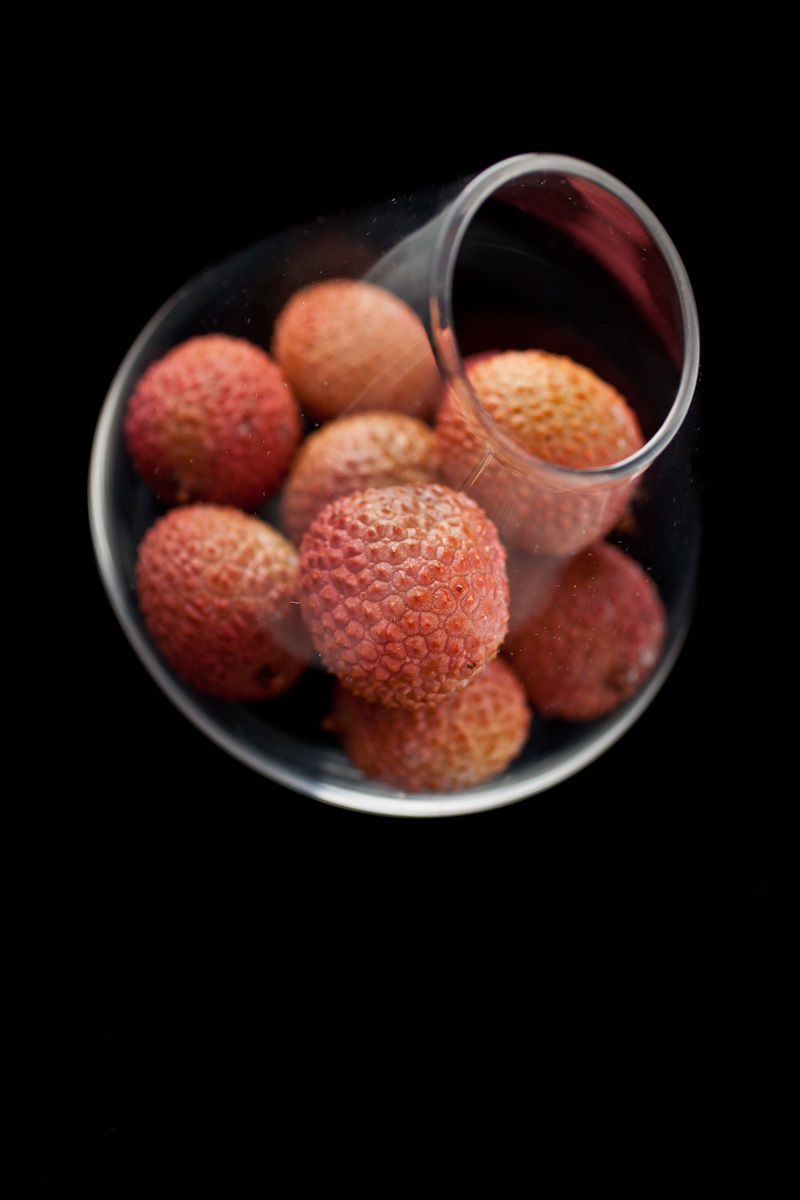
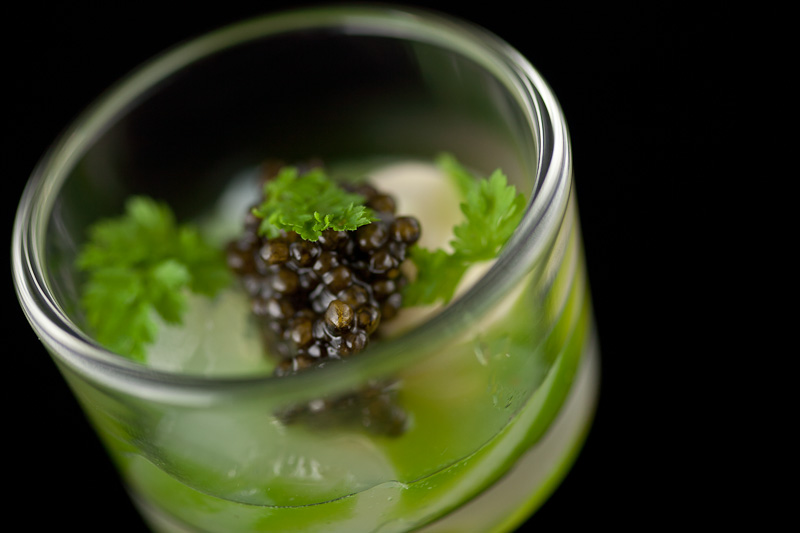
Drizzled into the bottom of the bowl is fresh chervil juice; this is made by blanching chervil and blending with ice water in a blender. Chervil has a distinctive, sweet, indefinable flavor that I still have trouble articulating (which makes it hard for me to picture its flavor in my head still). It blended with the rest of the ingredients very nicely, adding a sweet, cool note (sort of like a punchier cucumber juice might).
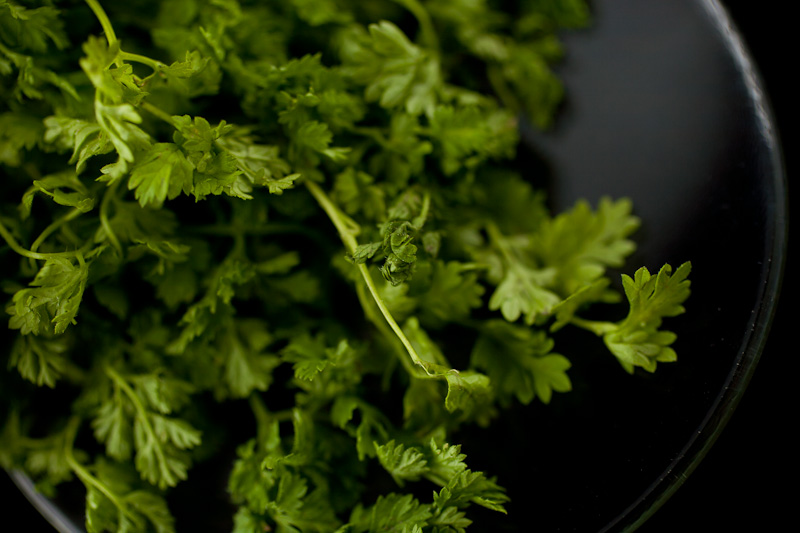
Finally, the cherry on top of this sundae is osetra caviar. I’ve never bought caviar before, and the few times I’ve had it in restaurants that are caliber enough to serve it, my specific memory of how it tastes is overshadowed by so many other factors (I’m sure I had it both times at Alinea, but I can’t really remember it because of the sensory overload). Turns out, caviar is hella expensive! Buying something that’s stupid expensive without knowing exactly what I’m doing is nerve-wracking and not a practice I generally indulge in. I mean, why would I ever drop $100 on a bottle of wine I’d never tasted? Answer: I wouldn’t.
There are quite a few outlets for caviar in the bay area, though. There are places in the Ferry Building that sell it, online retailers that are based in the area, and you can even find it at BevMo. Within the range of price for Osetra caviar, BevMo seemed to be at the low end ($45 for an ounce of it), while a place called the California Caviar Company offers some for well over $100. When I was buying my oysters from Piedmont Grocery, I saw a small sign saying they sold it too. Figuring at least I could ask some questions to learn a bit, I inquired about it. Piedmont carries a california-based caviar line called Lafayette Caviar, which seemed to be ‘kinda in the middle’ of the two prices of the other places. The employee I spoke with pointed out a $80 ounce of Russian Osetra, but then pointed to a $60 ounce of “California Select”, which he said his purveyor insisted was comparable to what’s coming out of the Caspian Sea these days, but is farmed in Sacramento. I figured I might as well try it, so I bought the lower-end one.
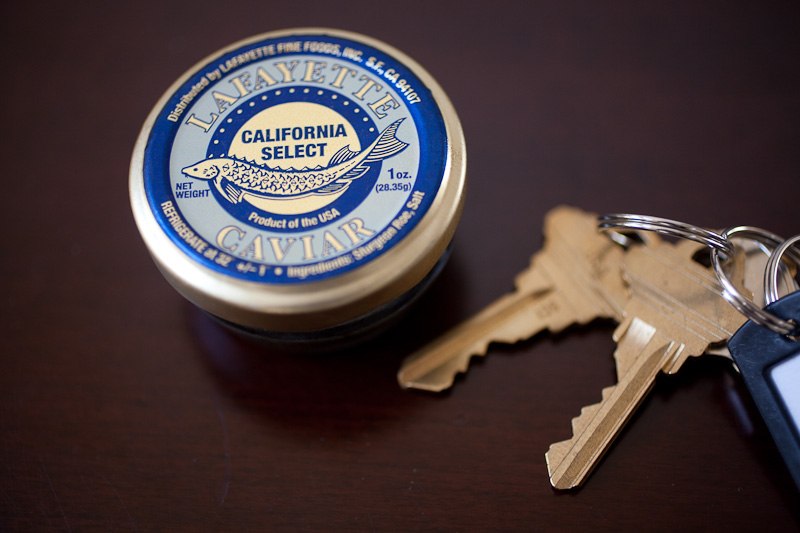
As far as caviar experiences go, I would say this was ‘pretty ok’. My impression wasn’t strong enough to motivate me to ever buy this again (unlike truffle, which I’d buy all day long if I could). Maybe that’s testament to it not being that awesome then? The flavor was a balance between nutty, salty, and ‘fishy’ and was perfectly fine. The texture was a little ‘gummy’ and the eggs looked in many cases to be a little wilted. What does that imply? Improper storage? Past its shelf life? It still tasted nice enough when paired with all the rest of these ingredients, and overall I really loved this one. It’s luxurious and makes me feel like a bit of a gangster when eating it.
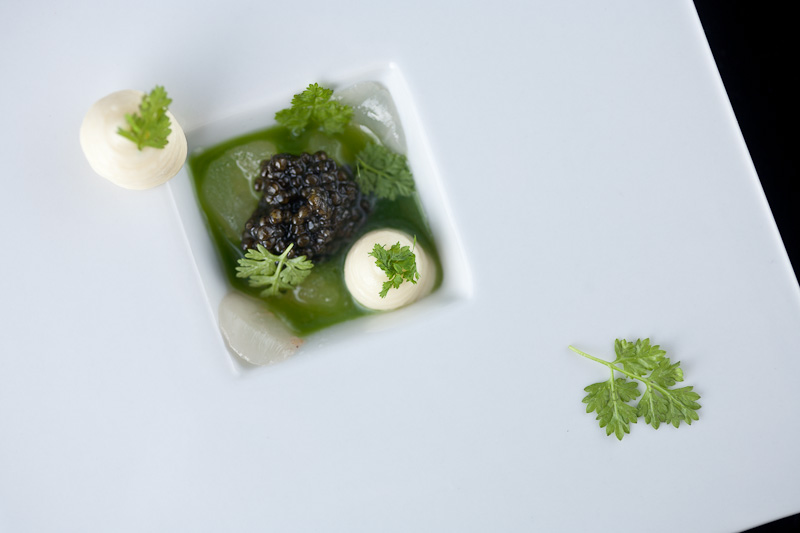
Amazing. I wish I lived near the ocean–oysters are so expensive at restaurants. And I also wish that my tasting-imagination was better (and that I knew what caviar is like)–I’m really curious about what all of this was like together. I grew up eating lychees, but I’ve never had them in a dish.
Out of curiosity, what kind of gelatin do you use? A lot of the fillings in Hermé’s macarons are set with gelatin, and he calls for “leaf gelatin.” I have no experience whatsoever using gelatin.
Hey Katie!
I’m with you on all counts: being able to roll up to a shop and buy oysters pretty arbitrarily makes me feel incredibly lucky to be living here at the moment. And I ALSO wish I was better at taste imagination! That, to me, seems like the main divider between someone like me (a hobbyist poser) and a chef in a restaurant who knows how to imagine flavors together. I think it’s a skill that can be learned, but takes practice and some educated guessing.
Caviar tastes like: fish. Super duper fishy. Sarah loves it, but she also loves anchovies and stuff like that, if that helps give you a picture. It’s a little salty, and a little (ever so slightly) nutty, but the main note is fishy. The texture is more the interesting part, it’s a little more silken and luxurious than tobiko (and bigger in radius).
I use 100% of the time leaf (or ‘sheet’) gelatin. It’s convenient (it’s pre-measured, and its very easy to just count off X sheets of it) and easy to use. You can usually find it in small (10-20 sheet) quantities at specialty baking shops, or can order it from Amazon. I’ve bought smaller 10-20 sheet packs since I started this project, but just caved and bought a full box (400 sheets) from Amazon for about $50. That sounds expensive, but driving back and forth to remote baking speciality shops is enough pain for me to be worth it. Sheet galatin comes in 3 ‘grades’–gold, silver, and bronze. Bronze is the cheapest usually, and it’s works just as well as gold or silver. All three grades have equal gelling power, but the weights differ to compensate (so gold gelatine, which is ‘the most pure’, is transparent and very thin and light, while bronze gelatin is thicker and more yellow in color and offers the same gelling power). I’ve always bought the cheapest I could find, which is usually bronze at most baking shops. The baking shop in Berkeley near me sells 20 sheets for something like 5 bucks I think.
Here’s a good shot of what it looks like:
http://fantes.com/images/20518baking_ingredients.jpg
To use it, put some sheets in ice water for about 5 minutes. It will ‘bloom’ (swell a bit and become floppy and very pliable). At this point, take it out and squeeze out the excess water with your fingers, then plop it in whatever you’re cooking (which, at this point, is likely to be warm, so the gelatin can dissolve).
Hello!! Your dishes look amazing!! Do you scale down recipes from the book to make smaller quantities?
Hi Norma!
Hm, sometimes I scale down, but educatedly. In the past, sometimes I’ve tried to scale down certain things and have been met with failure, other times it’s been successful. For example, some recipes seem huge and involve processing in a blender; when I half or quarter them, there’s too little to blend properly so the recipe fails. Other recipes which just involve simpler things like cooking on a stovetop can often be safely scaled down proportionately, provided my scale is accurate enough to handle it (lots of times, when dealing with hydrocolloids, the original amount is so small that halving it can’t be accurately measured on my scale).
Frustrating though this sounds, I’ve welcomed the times I’ve screwed up because I’ve inevitably learned more from failures than from successes. So I’m all for trying to scale things down and see what happens. If it goes wrong, you’ll clearly know it (that’s the great thing about a lot of this stuff…when you fail, you fail hard, so you learn quickly). And if it goes right, awesome! Either way, you win.
For this oyster recipe, nearly twice the required amount of cream was called for. After failing once (because of the odd separation issue), I tried again but halved the recipe, knowing that just steeping some oysters in cream wasn’t something that was too tricky. It worked fine. I didn’t halve the chervil juice though, because there’s a blending step and I know with my blender that if I put too little stuff in it, it just flings everything up against the sides of the blender and doesn’t actually blend anything. So I needed the weight of the full recipe to keep things pulled down to the blade of the blender as it spun.
Thanks–that’s really helpful. One more thing if you don’t mind: how comparable do you think are the properties of gelatin and agar agar? As I’ve mentioned before, I’m more or less a vegetarian (though I will eat fish while eating out–there’s no principle behind it really, except that most interesting restaurants aren’t accessible if you don’t at least eat seafood), so I wouldn’t normally go for making anything with gelatin. So, if there were any hope of doing something similar with agar agar, I’d definitely want to try that, but I’m so excited to be learning from Hermé’s book that I think I can overlook a few grams of gelatin here and there.
Hey katie;
You totally can, but with consequences. Agar is super-frequently used as a substitute for gelatin to accomodate vegetarian diets. If your curiosity outweighs your adamance about eating vegetarian you might try experimenting to get a feel for the differences. But in a nutshell:
–Agar has 2-3 times the gelling power of gelatin, so when substituting, reduce the amount by 2-3 times (specifically: 0.2%-0.5% by weight agar will set as gel, whereas 0.6%-1.7% gelatin is needed to form a similarly-strong gel).
–Agar has a higher (much higher) melting point. Gelatin gels melt at around 25-40C, where agar melts at around 80-90C. This means gelatin-based gels can melt in one’s mouth, while agar gels cannot. Gels made form each of these, then, have a different mouth-feel.
–Agar requires boiling to hydrate; gelatin can dissolve at lower (but warm) temperatures.
–Agar sets in a matter of minutes when cooled, whereas gelatin sets in a matter of hours. If you need to work with something after you’ve added agar, bear in mind if it cools quickly it can seize up on you.
I found this PDF incredibly helpful when trying to wrap my head around various hydrocolloids; it’s overkill for the cooking you’re doing, but might still be interesting to you;
http://blog.khymos.org/recipe-collection/